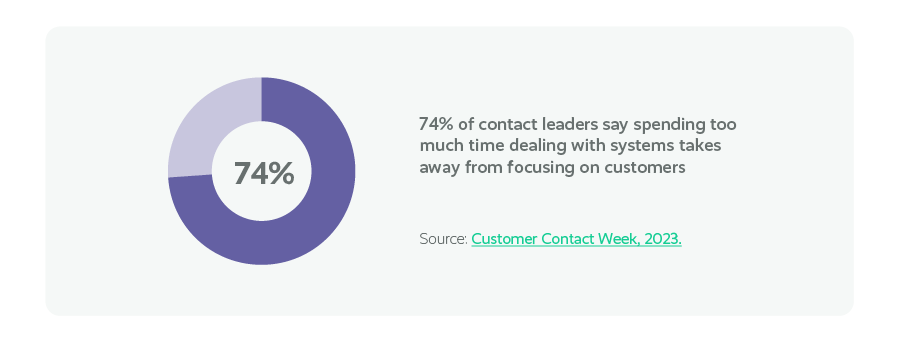6 Strategies To Improve First Contact Resolution
Customers who repeatedly contact agents for help can cost you — and more than just money.
Your contact center agents lose time to repeated contacts, and you’ll risk a decrease in customer satisfaction, too. Companies and contact center agents must implement First Contact Resolution (FCR) strategies.
Improve your FCR rate by learning what it is, why it matters, and how to improve it. We offer these six tips you can put to use immediately.

What Is First Contact Resolution?
FCR was originally called First Call Resolution, but as call centers have morphed into multichannel and omnichannel contact centers, FCR now stands for First Contact Resolution.
So what is First Contact Resolution? Simply put, FCR is the ability to resolve a customer issue or question the first time they reach out, eliminating the need for a second interaction. Poor FCR is a common issue in contact centers. If your company is struggling with your FCR rate, you’re not alone.
While boosting your First Contact Resolution rate may feel out of reach, it’s a meaningful metric and incorporates many elements of customer relationship management. Along with agent satisfaction, FCR is one of the biggest influences on the customer experience.
Why Is Improving First Contact Resolution Important?
When you improve First Contact Resolution rates, you not only trim operating costs from repeated customer interactions, but you have a positive impact on your contact center metrics and your company’s ability to retain satisfied customers and gain loyalty.
FCR strategies can increase selling opportunities, improve employee satisfaction, and serve as an important factor in contact center profitability. There are many First Contact Resolution benefits, which is why implementing an FCR strategy is key to having effective customer interactions and improving business overall.
Related Article: 6 Mistakes Hurting Your First Contact Resolution Metrics
How To Improve First Contact Resolution
1. Ensure Information Is At Agents’ Fingertips
Due to having too many cumbersome applications and tools, it can sometimes be hard for agents to find the information they need to resolve a customer issue quickly, leaving CX teams and customers frustrated. In fact, a 2023 Customer Contact Week report revealed that 74% of contact center leaders said agents dealing with CRM and internal knowledge base systems takes too much time away from building customer relationships.

That’s why it’s vital to create an easy-to-use, yet comprehensive, database containing details about products, solutions, and resolution steps. This database will reduce the time agents spend looking up information in different places and give them more time to deliver an outstanding customer experience. Efficient access to the necessary information is a best practice for improving your FCR rate.
The information and related resources needed to resolve customer issues are best kept in a customer service or customer relationship management (CRM) system. While these systems form the core of information, it’s critical to augment them with workforce engagement management (WEM) software so team members can make the most of every interaction. The main purpose of WEM software is to enable and empower agents to do their best work every day.
2. Empower Your Contact Center Agents
Agents who haven’t been given agency to address customers’ concerns on their own can quickly become frustrated, unmotivated, and lose their motivation within the span of a single interaction. Call center leaders have plenty of decisions to make daily related to agent performance — choices that directly impact the organization’s bottom line.
Allow agents the power to make their own decisions when supporting a dissatisfied customer. This ultimately means encouragement, acknowledgment, training, and coaching to ensure the success of contact center agents. Offering First Call Resolution awards may be a great tactic to help motivate agents throughout their workday.
3. Provide Contact Center Agents With Ongoing Coaching And Training
Many times, customers are forced to repeatedly interact with your company or they are repeatedly transferred to other teams because agents lack the necessary knowledge to help with an issue. This leaves customers feeling frustrated, and for good reason — interacting repeatedly until you find someone who can fix your problem is no one’s idea of a day well spent. It’s the very essence of a poor customer experience.
So take the time to properly coach agents on First Call Resolution strategies. Even longtime agents can benefit from ongoing training and development. You can begin by monitoring interactions to make sure agents are asking the right questions throughout the entirety of the conversation.
From there, you can build a plan to educate agents on contact resolution rates. By monitoring your FCR rate and analyzing the root cause, you are bound to improve your call center operations and create a positive experience for customers.
Related Article: Tips for Training Work-At-Home Agents
4. Ensure Your Contact Center Is Properly Staffed
The best CX center hires will have a full understanding of best practices and protocols, vast product knowledge, and the ability to handle emotional customers. They will also be willing and eager to continue learning about how to serve customers, even with complex issues. Soft skills like patience, empathy, and kindness also improve customer interactions.
Smart hiring is a First Contact Resolution best practice. By ensuring that the right people are hired as call center agents, first call resolution training will also be less complicated. Don’t hesitate to measure agents’ productivity and ensure each employee is effective.
It’s important that customers feel like the agent they’re speaking with is genuinely eager to help with their questions and concerns. Choosing the right people for the job is sure to help increase your First Contact Resolution rate and improve customer retention.
Of course, having a workforce management (WFM) solution also goes a long way toward effective and appropriate staffing levels. An AI-driven WFM gives CX managers a real-time view of planned staffing compared to actual staffing for every location and work type.
By using artificial intelligence to continually analyze and improve workforce management, an AI-based WFM lets managers plan, forecast, and schedule agents for multi-step interactions, keeping your FCR rates at optimal levels.
Related Article: Make Every Agent Your Best Agent with Workforce Management
5. Help Agents Navigate Escalated Issues
Escalated issues are normally a last resort for a customer to get their issue resolved, so educating agents on how they can effectively and efficiently handle escalated calls is a big opportunity. An agent who takes great care of a customer on an escalated case will show the customer that your business really does want to help.
Left unchecked or unaided, employees who don’t feel well-equipped to handle escalated issues can drive up contact avoidance — the deliberate effort not to service customers. The best way to mitigate this type of negligence is to set boundaries and expectations with a contact avoidance policy.
Related Content: Combatting Contact Avoidance and Creating the Right Policy To Manage It
6. Streamline The Contact Transfer Process
While FCR is the goal, if you ultimately can’t achieve it, make sure you provide a smooth path to the next step for the customer. Coach agents to be clear with customers about where they will be transferred and why. This clarity will help them feel like the contact center agents are still capable of resolving their issue as quickly as they can.
Call center agents should have transfer details at their fingertips so they can get customers where they need to go easily. Additionally, making the right transfer means it’s more likely the customer won’t need to contact your customer support center again about this issue, which will, in turn, increase customer satisfaction.
Take A Step Today To Improve First Contact Resolution
While these six best practices will make material improvements to your CX center’s FCR rate, there’s no need to tackle all of them at once. To get started, choose one of them and take meaningful steps to get started.
Once your company has mapped out its First Contact Resolution strategy and goals and started to track FCR rates properly, it’s important to stay consistent. While not every customer issue or concern can be resolved easily on first contact, these FCR best practices will ensure that you can achieve a higher First Contact Resolution rate.
Request a demo to see how Playvox solutions can help you boost FCR rates and improve efficiency in your contact center.






